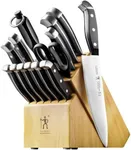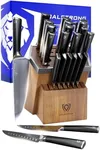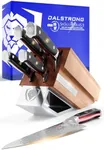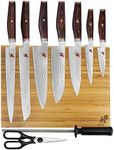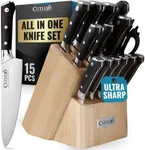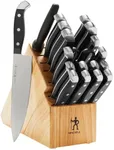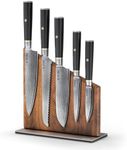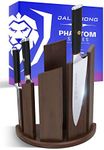Buying Guide for the Best Professional Knife Sets
Choosing the right professional knife set is crucial for both home cooks and professional chefs. A good knife set can make food preparation more efficient, enjoyable, and safe. When selecting a knife set, it's important to consider the types of knives included, the quality of the materials, and how the knives feel in your hand. Here are some key specifications to help you make an informed decision.Blade MaterialThe blade material is important because it affects the knife's sharpness, durability, and ease of maintenance. Common materials include stainless steel, high-carbon stainless steel, and ceramic. Stainless steel is resistant to rust and easy to maintain, making it a good all-around choice. High-carbon stainless steel is harder and holds an edge longer but requires more care to prevent rust. Ceramic blades are extremely sharp and lightweight but can be brittle and prone to chipping. Choose a material based on your willingness to maintain the knives and your need for sharpness and durability.
Handle MaterialThe handle material affects the knife's comfort, grip, and durability. Common handle materials include wood, plastic, and composite. Wood handles offer a traditional look and feel but require more maintenance to prevent cracking and warping. Plastic handles are durable and easy to clean but may not provide the best grip when wet. Composite handles combine the best of both worlds, offering durability and a good grip. Choose a handle material that feels comfortable in your hand and suits your maintenance preferences.
Knife Types IncludedA professional knife set typically includes several types of knives, each designed for specific tasks. Common knives in a set include a chef's knife, paring knife, bread knife, utility knife, and slicing knife. Some sets may also include specialty knives like a boning knife or a santoku knife. Consider the types of food you frequently prepare and choose a set that includes the knives you will use most often. A versatile set with a good variety of knives is ideal for most users.
Weight and BalanceThe weight and balance of a knife affect how it feels and performs in your hand. A well-balanced knife will feel comfortable and reduce fatigue during extended use. Heavier knives can provide more power for cutting through tough ingredients, while lighter knives offer more control and precision. Test the knives in your hand if possible to find a weight and balance that feels right for you. Your personal preference and the type of cutting tasks you perform will guide your choice.
Edge RetentionEdge retention refers to how long a knife stays sharp before needing to be re-sharpened. This is important because a sharp knife is safer and more efficient to use. High-carbon stainless steel and ceramic blades typically offer better edge retention than regular stainless steel. Consider how often you are willing to sharpen your knives and choose a set with good edge retention to minimize maintenance.
Storage OptionsProper storage is essential to keep your knives in good condition and ensure safety. Knife sets often come with a storage block, magnetic strip, or protective sheaths. A storage block is convenient and keeps knives organized, but it takes up counter space. A magnetic strip saves space and allows easy access, but it requires wall installation. Protective sheaths are great for keeping knives safe in a drawer but may be less convenient for frequent use. Choose a storage option that fits your kitchen layout and usage habits.
